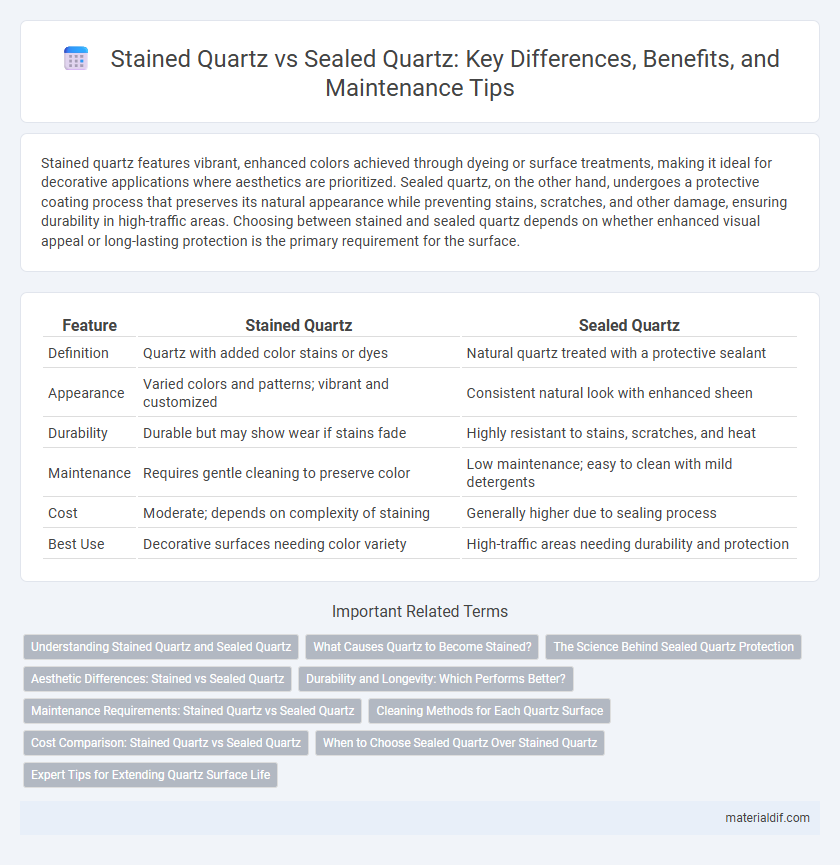Stained quartz features vibrant, enhanced colors achieved through dyeing or surface treatments, making it ideal for decorative applications where aesthetics are prioritized. Sealed quartz, on the other hand, undergoes a protective coating process that preserves its natural appearance while preventing stains, scratches, and other damage, ensuring durability in high-traffic areas. Choosing between stained and sealed quartz depends on whether enhanced visual appeal or long-lasting protection is the primary requirement for the surface.
Table of Comparison
| Feature | Stained Quartz | Sealed Quartz |
|---|---|---|
| Definition | Quartz with added color stains or dyes | Natural quartz treated with a protective sealant |
| Appearance | Varied colors and patterns; vibrant and customized | Consistent natural look with enhanced sheen |
| Durability | Durable but may show wear if stains fade | Highly resistant to stains, scratches, and heat |
| Maintenance | Requires gentle cleaning to preserve color | Low maintenance; easy to clean with mild detergents |
| Cost | Moderate; depends on complexity of staining | Generally higher due to sealing process |
| Best Use | Decorative surfaces needing color variety | High-traffic areas needing durability and protection |
Understanding Stained Quartz and Sealed Quartz
Stained quartz refers to natural quartz that has undergone a staining process to enhance or alter its color for aesthetic purposes, often used in decorative applications. Sealed quartz, on the other hand, is quartz that has been coated with a protective sealant to prevent staining, enhance durability, and maintain its polished appearance over time. Understanding these differences helps in selecting the right quartz type for specific uses, ensuring longevity and desired visual effects.
What Causes Quartz to Become Stained?
Quartz becomes stained primarily due to exposure to external contaminants such as oils, rust, and mineral deposits that penetrate the porous surface before sealing. Iron oxide buildup and tannins from food or beverages can also cause discoloration on unsealed quartz countertops. Sealing quartz creates a protective barrier, preventing these stains by blocking contaminants from adhering to or absorbing into the stone surface.
The Science Behind Sealed Quartz Protection
Sealed quartz surfaces maintain their pristine appearance through a protective barrier that prevents moisture, oils, and stains from penetrating the porous structure. This sealing process chemically reacts with the quartz, filling microscopic crevices and enhancing resistance to discoloration and bacterial growth. Understanding the molecular interaction between sealants and quartz is crucial for maximizing durability and maintaining the stone's aesthetic appeal over time.
Aesthetic Differences: Stained vs Sealed Quartz
Stained quartz exhibits rich, customized color variations that enhance the natural veining and texture, creating unique visual depth. Sealed quartz surfaces maintain a consistent, glossy finish that protects the stone while showcasing its inherent shimmer and brightness. The aesthetic distinction lies in stained quartz offering artistic, layered hues, whereas sealed quartz emphasizes sleek, polished clarity.
Durability and Longevity: Which Performs Better?
Stained quartz, enhanced with pigments, may experience slight surface wear over time, whereas sealed quartz offers superior resistance to stains, scratches, and moisture due to its protective coating. The sealing process significantly improves the quartz's durability by creating a barrier against everyday damage, resulting in longer-lasting countertops with minimal maintenance. For applications requiring maximum longevity and sustained aesthetic appeal, sealed quartz outperforms stained quartz in durability and overall performance.
Maintenance Requirements: Stained Quartz vs Sealed Quartz
Stained quartz surfaces require more frequent cleaning and occasional reapplication of sealants to prevent absorption of stains and maintain their appearance. Sealed quartz offers enhanced resistance to liquids and stains, reducing the need for intensive maintenance and making it easier to clean with just mild soap and water. Regular upkeep of stained quartz involves careful attention to spills and potential damage, whereas sealed quartz provides a more durable, low-maintenance option for long-lasting surface protection.
Cleaning Methods for Each Quartz Surface
Stained quartz requires gentle cleaning techniques to avoid worsening discoloration, typically involving mild soap and water or specialized quartz cleaners to maintain surface integrity. Sealed quartz surfaces benefit from more robust cleaning methods, allowing the use of pH-balanced cleaners and alcohol-based solutions to effectively remove stains without damaging the protective sealant. Regular maintenance for both types should avoid abrasive pads or harsh chemicals to preserve the appearance and longevity of the quartz surfaces.
Cost Comparison: Stained Quartz vs Sealed Quartz
Stained quartz typically incurs higher costs due to the additional labor and materials required for applying and maintaining the stain, while sealed quartz involves lower expenses focused on protective treatments that enhance durability without altering the stone's appearance significantly. The price difference between stained quartz and sealed quartz varies based on the quality of sealant or staining product, with staining often demanding specialized expertise. Homeowners should consider long-term maintenance costs, as stained quartz may require periodic reapplication of stains, whereas sealed quartz primarily involves surface resealing to retain its resilience against stains and scratches.
When to Choose Sealed Quartz Over Stained Quartz
Sealed quartz offers enhanced resistance to stains, scratches, and moisture, making it ideal for high-traffic areas like kitchens and bathrooms where durability is critical. Stained quartz, while visually appealing with vibrant colors, may require more maintenance and is better suited for decorative applications or low-use surfaces. Opt for sealed quartz when longevity and ease of cleaning are priorities, especially in environments prone to spills and heavy use.
Expert Tips for Extending Quartz Surface Life
Stained quartz surfaces require immediate cleaning with a non-abrasive, pH-balanced cleaner to prevent discoloration, while sealed quartz benefits from periodic resealing to maintain its protective layer against moisture and stains. Experts recommend using gentle, non-acidic cleaning agents and soft cloths to avoid surface damage and prolong durability. Avoid exposing both stained and sealed quartz to harsh chemicals or direct heat to preserve their structural integrity and aesthetic appeal.
Stained Quartz vs Sealed Quartz Infographic

 materialdif.com
materialdif.com